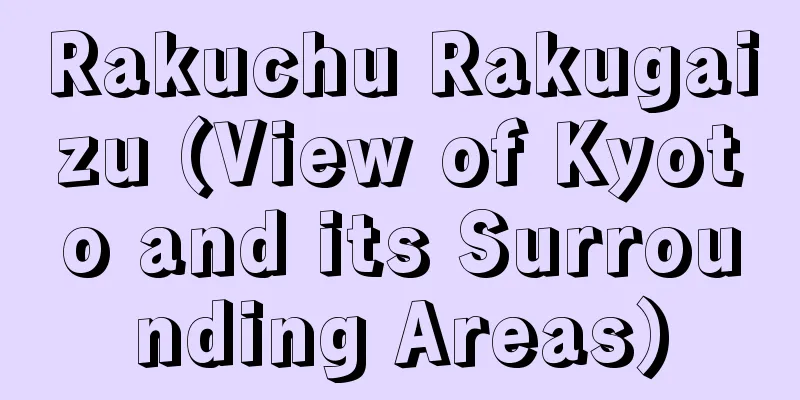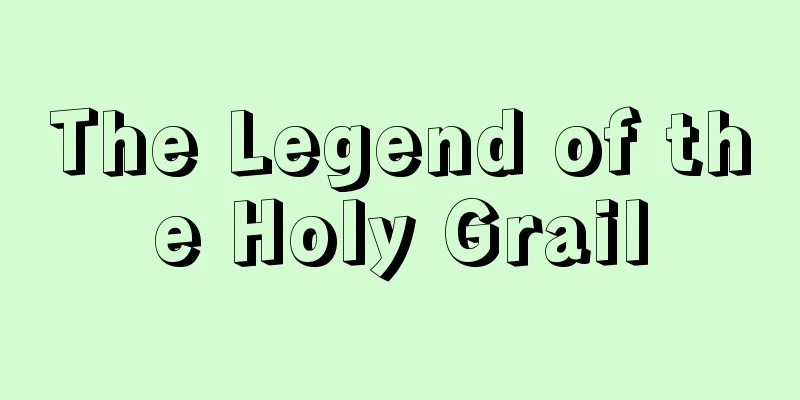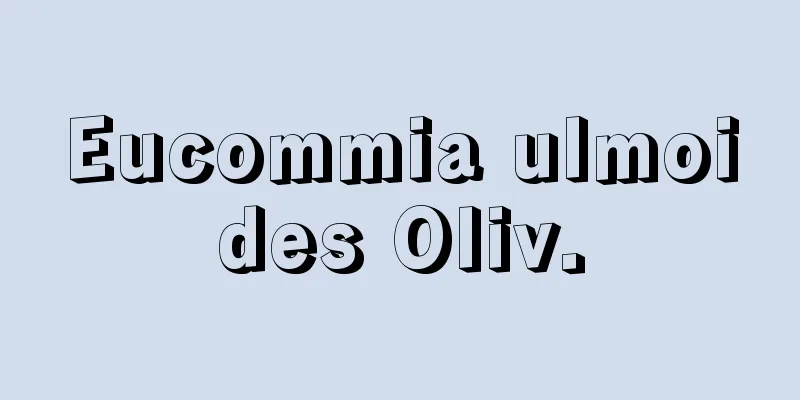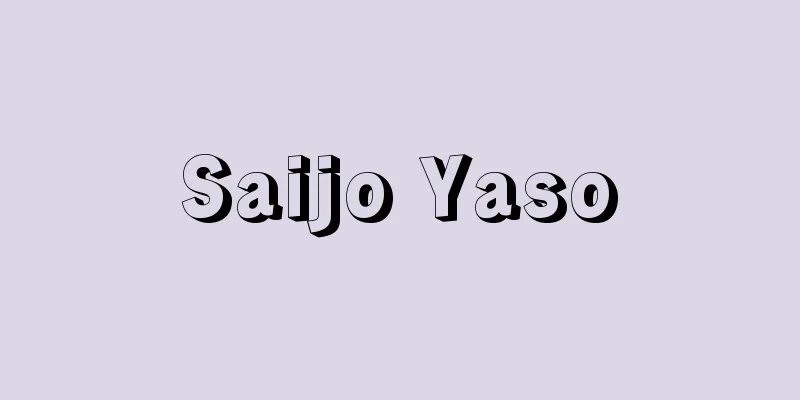Rakuchu Rakugaizu (View of Kyoto and its Surrounding Areas)

|
One of the subjects of Japanese painting. It depicts the state of Kyoto city (rakuchu) and suburbs (rakugai), and is a type of urban genre painting. It was popular from the end of the Muromachi period to the beginning of the Edo period. Some were in the form of scrolls or albums, but the majority were in the form of a pair of six-panel folding screens, with the right panel depicting part of Kyoto city against the backdrop of the scenery of the Higashiyama area east of the Kamo River, and the left panel depicting a similar part of Kyoto city against the backdrop of the Kitayama to Nishiyama mountains. Famous shrines, temples, and other famous places scattered in Kyoto city and beyond are covered, and various landscapes throughout the four seasons or twelve months, as well as festivals such as the Gion Festival and the Kamo Horse Races, are depicted in detail along with the people who gather there to enjoy themselves. The rich traditions of paintings of the four seasons and famous places, which were the subject of Yamato-e paintings, flowed through these works, but the crucial difference between these and the Rakuchu Rakugai-zu is that the former treat the various aspects of Kyoto as sentimental landscapes inspired by waka poetry and classical literature, whereas the Rakuchu Rakugai-zu captures the entire capital as it is today. Therefore, the composition of the landscape clearly reflects the economic conditions of the capital in each era, the location of political power, and trends. It is known from an article in the Sanetaka Koki that Tosa Mitsunobu painted "Kyoto" on a folding screen in 1506 (Eisho 3), and it is believed that the subject of painting had been established around that time, but unfortunately there are no surviving pieces going back that far. The oldest surviving work is the Rakuchu Rakugaizu folding screen, formerly owned by the Machida family (now the National Museum of Japanese History), which shows a landscape from the 1530s. Together with the Uesugi family version (owned by the Uesugi family in Yamagata), which depicts Kyoto about 30 years later and is said to have been a gift from Oda Nobunaga to Uesugi Kenshin, these are called the Early Rakuchu Rakugaizu. Both paintings depict the palaces of the shoguns (Ashikaga Shogunate), Tenkyu, and Hosokawa (Kanrei), and reflect the prosperity of the capital at the end of the Muromachi period. Then, during the reign of Toyotomi Hideyoshi, Jurakudai and Hokoji Temple became the central focus of the landscape (Jurakudai Screen, six-panel folding screen, Mitsui Bunko, Tokyo), and when the Tokugawa government took over, Nijo Castle was depicted on the left screen and Hokoji Temple on the right screen, creating a painting that sensitively reflected the unstable political situation (Rakuchu Rakugaizu byobu, Tokyo National Museum). Then, from the Genna/Kan'ei period (1615-1644) onwards, when the Tokugawa Shogunate was moving towards stability, Nijo Castle was placed at the centre of the left screen, while the right screen began to depict the Gion Festival and the Imperial Palace in large scale, and all subsequent Rakuchu Rakugaizu paintings followed this landscape composition. However, this was the end of its vitality as a subject, and although numerous works were produced afterwards, they became very typified and did not show any new developments. In addition to the above, there are many other copies remaining, including the copy at the Hayashibara Museum of Art in Okayama, the copy at Shokoji Temple in Toyama, and the copy at the Suntory Museum of Art in Tokyo. [Satoru Sakakibara] "The Great View of Kyoto and Its Surrounding Areas" edited by Ishida Naotoyo, Naito Masaru, and others (1987, Shogakukan) " "Japanese Art 20: Genre Paintings of the Early Modern Period" edited by Takeda Tsuneo (1967, Shibundo) " "Japanese Art 121: Kyoto and Its Surrounding Areas" edited by Tsuji Tsuneo (1976, Shibundo) Source: Shogakukan Encyclopedia Nipponica About Encyclopedia Nipponica Information | Legend |
|
日本画の画題の一つ。京都の市中(洛中)と郊外(洛外)のありさまを描いたもので、一種の都市風俗画。室町末期から江戸初期にかけて盛行した。画巻形式や画帖(がじょう)形式のものもあったが、大多数は六曲一双の屏風(びょうぶ)形式をとり、右隻(うせき)にはおもに鴨川(かもがわ)以東の東山一帯の景観を背景に洛中の一部を、左隻には北山から西山を背景に同じく洛中の一部をあてる。洛中洛外に点在する著名な神社、仏閣、諸名所が網羅され、さらに四季ないしは12か月にわたる諸景物や祇園(ぎおん)祭礼、賀茂競馬(かものくらべうま)などといった祭礼行事が、そこに集い遊楽する人々の姿とともに事細かに写し出される。そこには大和(やまと)絵の画題であった四季絵や名所絵の伝統が豊かに流れていたが、それらと洛中洛外図とが決定的に異なる点は、前者が京洛の諸様相を和歌や古典文学などに触発された情趣的な景物として扱っているのに対し、洛中洛外図では、現在「かくある」姿として都の全体がとらえられている点にある。それゆえその景観構成には、各時代の都の景気や政治権力の所在、動向などが明瞭(めいりょう)に反映された内容となっている。 洛中洛外図については、1506年(永正3)土佐光信(とさみつのぶ)が「京中」を屏風に描いたことが『実隆公記(さねたかこうき)』の記事で知られ、ほぼこのころまでには画題として成立していたとみられるが、残念ながらそこまでさかのぼる遺品はない。現存最古の作品は町田家旧蔵(現国立歴史民俗博物館)の『洛中洛外図屏風』で、1530年代の景観を示す。これより約30年後の京都を描き、織田信長が上杉謙信(けんしん)に贈ったと伝えられる上杉家本(山形・上杉氏蔵)を加えて初期洛中洛外図とよぶ。ともに公方(くぼう)(足利(あしかが)将軍家)や典厩(てんきゅう)、細川(管領(かんれい))の一連の殿舎が描き込まれ、室町末期の都の景気を写し出している。ついで豊臣(とよとみ)秀吉の時代になると、聚楽第(じゅらくだい)と方広寺とが景観の中核となり(東京・三井文庫の六曲一隻『聚楽第図屏風』)、さらにこれが徳川政権への交代期になると、左隻に二条城、右隻に方広寺を大きく描き、不安定な政情を敏感に反映した画面となる(東京国立博物館の『洛中洛外図屏風』)。そして徳川幕府が安定に向かう元和(げんな)・寛永(かんえい)期(1615~44)以降は、左隻の中心に二条城を置き、右隻は祇園会(え)と内裏(だいり)とを大きく描くようになり、以後の洛中洛外図はすべてこの景観構成を踏襲する。しかし画題としての生命力はここまでで、その後おびただしく制作されたが類型化が著しく、新たな展開をみせずに終わった。遺品は前記のほか、岡山・林原美術館本、富山・勝興寺本、東京・サントリー美術館本などまことに多い。 [榊原 悟] 『石田尚豊・内藤昌他監修『洛中洛外図大観』(1987・小学館)』▽『武田恒夫編『日本の美術20 近世初期風俗画』(1967・至文堂)』▽『辻惟雄編『日本の美術121 洛中洛外図』(1976・至文堂)』 出典 小学館 日本大百科全書(ニッポニカ)日本大百科全書(ニッポニカ)について 情報 | 凡例 |
<<: Lac dien (English spelling)
>>: Lactantius (English notation) Lucius Caelius(Caecilius) Firmianus Lactantius
Recommend
Reverse dilution method
…It is extremely difficult to quantitatively sepa...
Local newspaper
This is a high-quality paper made specially for b...
Camera Eye
...This work uses experimental modernist techniqu...
Prince Takehito
Year of death: July 5, 1913 Year of birth: Bunkyu ...
Swiss Apparel
...The characteristics of the ideological content...
Rikuka
A scholar from ancient China in the early Western...
Seal Netsuke - Insho Netsuke
...They are inserted between the obi belts. (6) T...
Protopterus aethiopicus (English spelling) Protopterusaethiopicus
…Lungfish [Hibiya Kyo]. . . *Some of the terminol...
Dampier, William
Born: 1652. East Coker, Somerset. [Died] March 171...
Tokyo University of Education
A national university established in 1949 (Showa ...
Vézelay - Vézelay (English spelling)
A small village in the Yonne department in centra...
Enkoji Temple (Hiroshima)
…A temple of the Daikakuji school of the Shingon ...
Ibn Ḥayyān (English spelling) Ibn Hayyan
…In philology, the Amāli by al-Qālī (901-967) is ...
Carissa
…It is an evergreen shrub of the Apocynaceae fami...
Cow shell - Cow shell
Another name for a shellfish in the cowrie family,...









